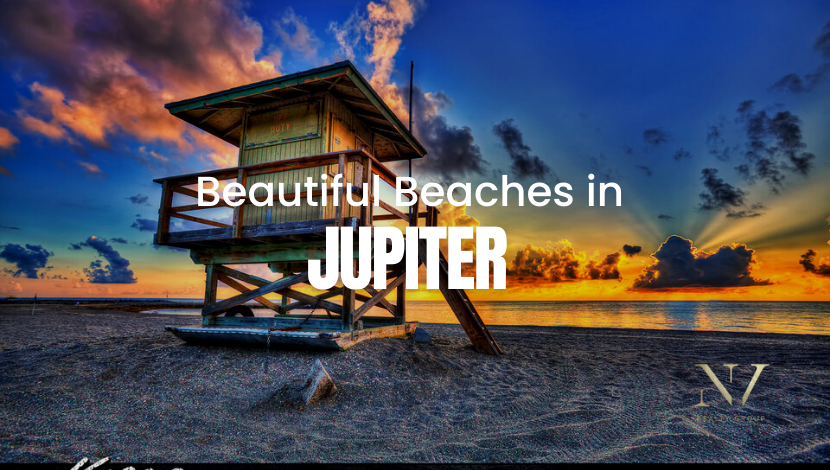
The secret is out: Jupiter, Florida has the most beautiful beaches, the most prestigious golf clubs, and the most opulent, oceanfront communities. The town, which was first occupied by the Hobe Native American tribe, was officially incorporated in 1925. At that time, the area was well known for its agriculture, fishing, and illegal booze. Because of its close proximity and direct cross from the inlet to the Bahamas, rum-running provided extra money for residents during difficult financial times.
Today, Jupiter is characterized as an upscale place to live; yet, it clings to the simple, laid-back lifestyle of its historic days: relaxing by the beach, fishing from the surf, and drinking rum. The beaches in Jupiter are worth a visit, and once folks step into its crystal clear waters, they are likely to never desire to dip a toe into the murky shores in the Northeast. Starting from the north end of town and meandering south toward the Juno Beach Pier, here are the best beaches in Jupiter.
The Nature Conservancy Blowing Rock Preserve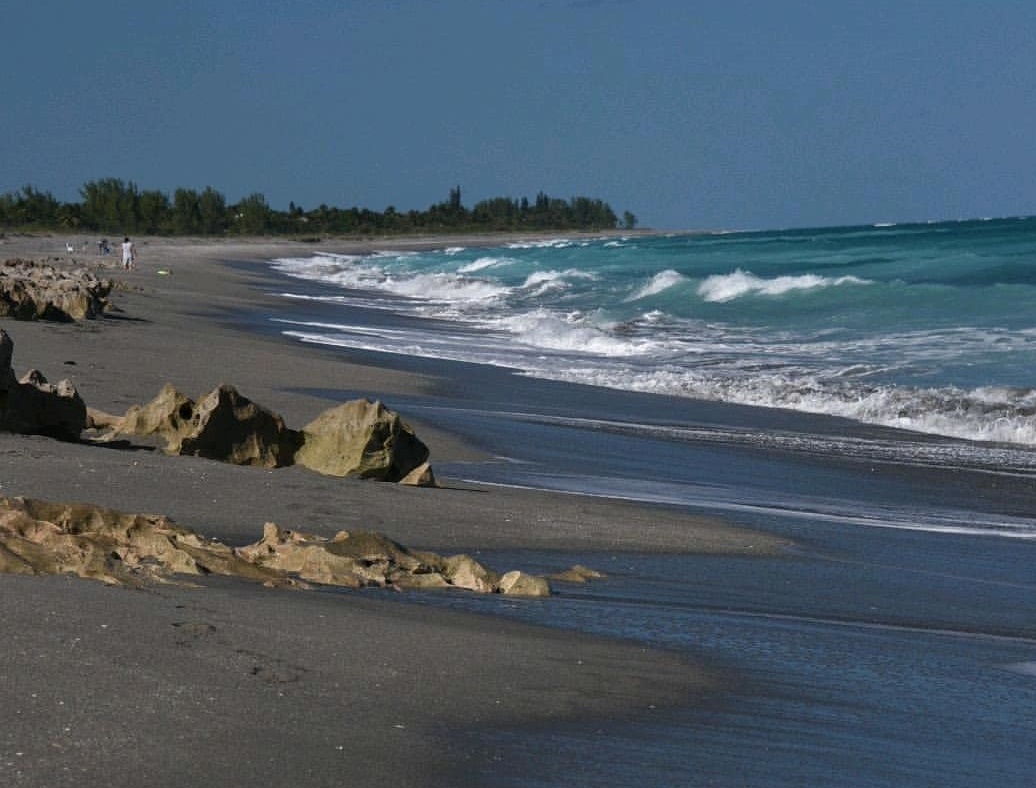
PHOTO CREDIT: KLIM7254 VIA INSTAGRAM
Located on posh, private Jupiter Island, the Nature Conservancy Blowing Preserve is an environmental treasure. The 73-acre barrier island highlights native coastal habitats and features five trails and scenic walks: the Beach trail, the Lagoon trail, the Dune trail, the Mangrove Boardwalk, and the Pollinator Garden Walk. The Beach Trail, which is the main pathway to access the beach, offers natural maritime shade, benches, viewing platform and staircase to the white sand coast. The Lagoon Trail loops around the Indian River Lagoon shoreline and through saltwater marshes and tidal creeks. Guiding visitors to the apex of the beach dune, the Dune Trail presents panoramic views of the Blowing Rocks. The 300-foot long Mangrove Boardwalk showcases the mangrove forest and overlooks the lagoon. This boardwalk offers a ramp for those needing assistance. Finally, the Pollinator Garden Scenic Walk is a short jaunt through native habitats and colorful flora. Of course, the hallmark of the preserve is the “blowing rocks.” At high tide, the ocean waves splash against the limestone rocks, making them appear as if they are blowing through the wind. Rough seas can soar saltwater upward of 50 feet, gifting visitors with a spectacular show of nature’s strength and beauty. At low tide or with calm seas, beachgoers enjoy frolicking in the ocean or snorkeling around the rocks and reefs. Typically, the summer months allow the Atlantic to remain calm and clear. Blowing Rock Preserve came to fruition following the generous land donation from Jupiter Island residents in 1969. Recognizing its environmental beauty, residents did not want the land to be developed but rather enjoyed by everyone. Jupiter Island native Nathaniel Reed and philanthropist Rosita Hawley Wright led the charge to protect the preserve and restore its natural habitat. Today, the barrier island is home to numerous loggerhead turtle nests, endangered plants and species, and tropical hammocks. The Hawley Education Center and Nathaniel Pryor Reed Classroom offer various exhibits, public lectures, and workshops to teach others the importance of coastal conservation. A peaceful place, the Nature Conservancy Blowing Rock Preserve is a unique, beautiful beach that makes people feel as if they are on a deserted island for the day.
Coral Cove Park
PHOTO CREDIT: KIM SENG VIA FLICKR CC2.0
Located just south of Blowing Rocks Preserve, Coral Cove Park in Tequesta, Florida is another saltwater treasure. This 14.5 acre park is ideal for families who wish to camp out at the beach for a day. In addition to a 600-feet guarded swim area, the park features a picnic area, charcoal grills, outdoor showers, playground, restrooms, and kayak/canoe launch and trails. The Jupiter Waterway Trail, a series of trails that connects to the Loxahatchee River, Intracoastal Waterway, and Jupiter Inlet is accessible from the park. This waterway trail is recognized by the DEP Greenways and Trails System, and it is ideal for canoes, kayaks, and paddleboards. An interactive, mobile map identifies eco-tourism amenities and attractions, both on and offshore. A quiet beach and park, Coral Cove represents Old Florida beauty and charm.
Dubois Park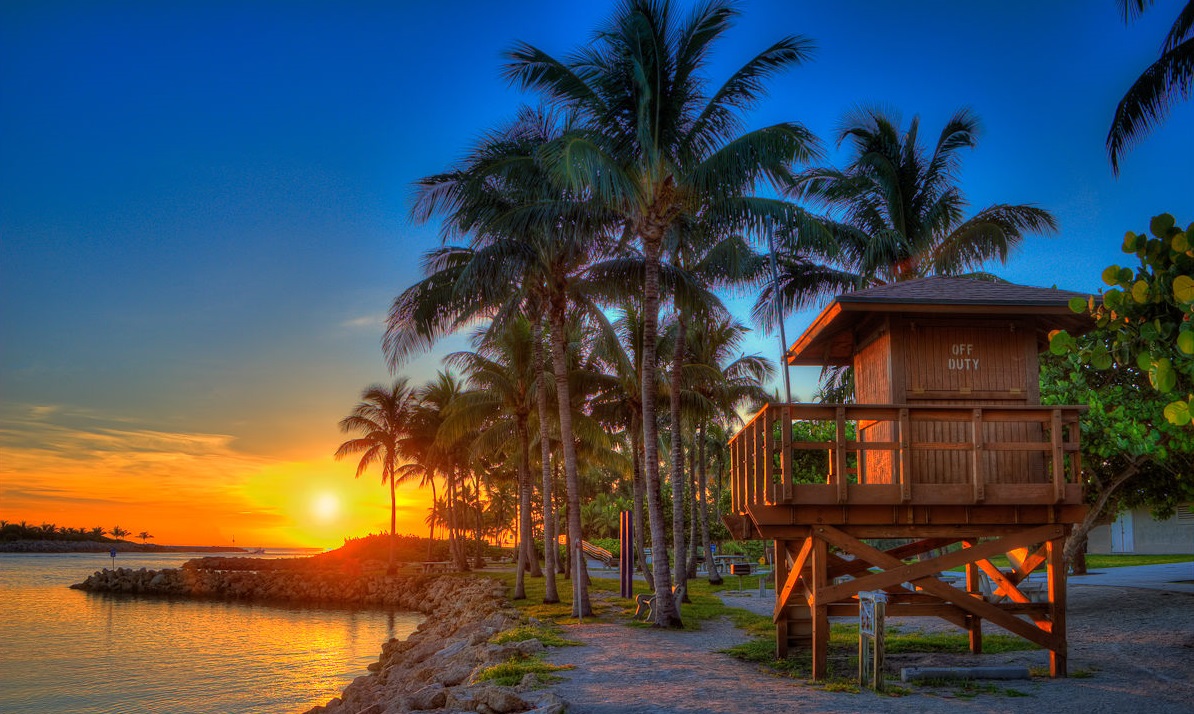
PHOTO CREDIT: KIM SENG VIA FLICKR CC2.0
Dubois Park is ideally situated at the mouth of the Jupiter Inlet, giving guests the opportunity to enjoy both the Intracoastal, Inlet, and Atlantic Ocean. Spanning nearly 19 acres, Dubois Park is rich in history and accolades. The award-winning park recently received the NACPRO distinction for its excellent facilities and design. Upon entering the park, guests first notice the “house on a hill.” Known as the Dubois Pioneer Home, this historic homestead was built in 1898 on a Native American shell mound. Originally standing 20-feet high, this is one of the last remaining ancient middens. Also located within the park is the Pineapple House, a small wooden shed formerly used to store pineapples, a crop Henry Dubois harvested on the property. Numerous artifacts and archeological finds have been discovered around these structures. Apart from the historical element, Dubois Park is famously known for its wide, guarded beach area at the corner of the Intracoastal and Inlet. Here, children enjoy frolicking in the gentle waves, building sandcastles, and searching for shark teeth. Other amenities at the park include a spacious picnic area with covered pavilions, charcoal grills, age-specific playgrounds, restrooms and showers, kayak/canoe/paddleboard launch, boat ramp, boat slips (for daytime use only), wildlife viewing area, fishing dock, and walking trails. Guests enjoy exploring the tropical oasis, fishing from the jetty’s, swimming in the ocean, collecting seashells, watching yachts cruise through the inlet, snorkeling in the ocean, and relaxing under the shaded pavilions. For private parties, guests may contact the Palm Beach County Parks and Recreation and rent a pavilion for a small fee. The turquoise blue water, lush foliage, and iconic Jupiter Lighthouse serve as spectacular backdrops for family gatherings, birthday parties, or any impromptu celebration.
Carlin Park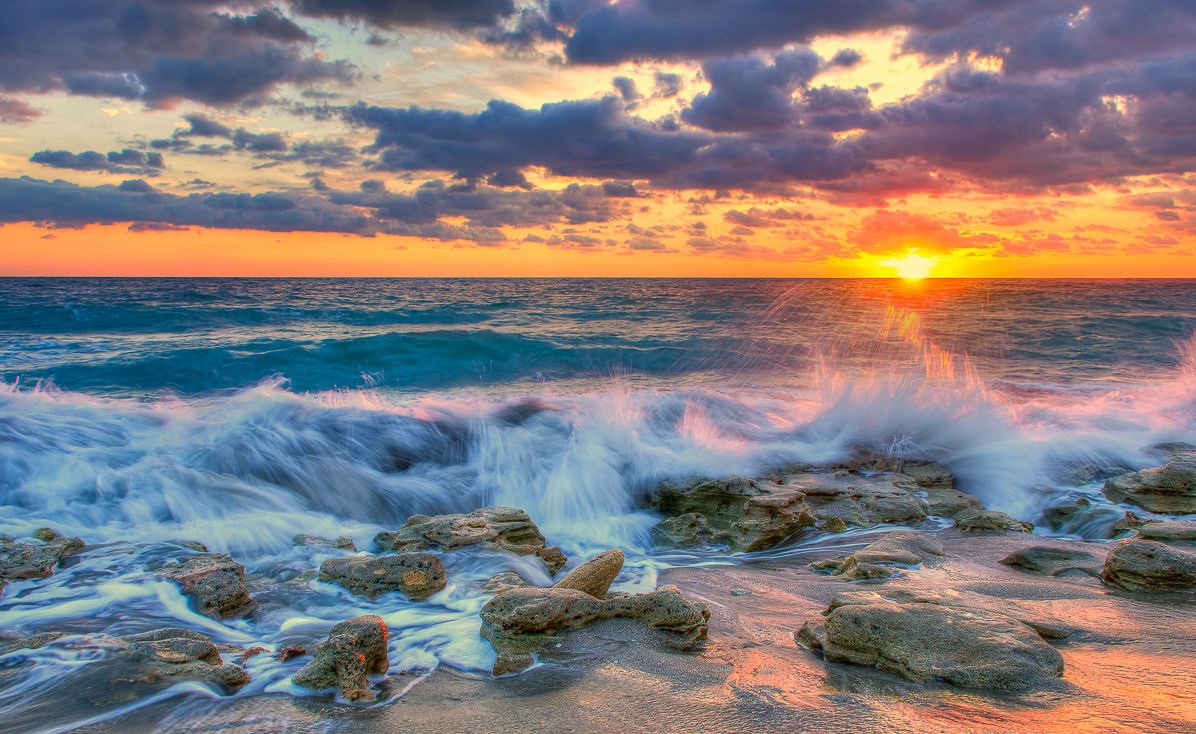
PHOTO CREDIT: KIM SENG VIA FLICKR CC2.0
Carlin Park is the perfect place for beachgoers who enjoy relaxing in the sun, participating in recreational activities, meeting new friends, observing Loggerhead turtles, surfing or snorkeling in the saltwater, and divulging in delicious brunches and lunches at Loggerhead Cafe. The park, which spans more than 120 acres, features 3,000 feet of guarded ocean water, bicycle trails, jogging path, exercise course with 20 cardio stations, softball field, basketball court, sand volleyball, three playgrounds, six tennis courts, bocce court, restrooms, restaurant, showers, private picnic options, and several waterfront pavilions with their own charcoal grills and picnic tables. Additionally, the park has its own amphitheater, the Seabreeze, which regularly hosts live music, festivals, and special events. The annual Shakespeare by the Sea production is always a treat for locals and tourists. Located off A1A, Carlin Park is well known for its surf and snorkel summer camps as well as its laid-back, on-site restaurant, The Lazy Loggerhead. This cafe is famous for its creative cuisines and bountiful brunches. Be sure to get there early; the restaurant closes at 2 p.m. each day. Other nearby dining establishments include Food Shack, Hog Snapper, and Three Natives.
Jupiter Beach Park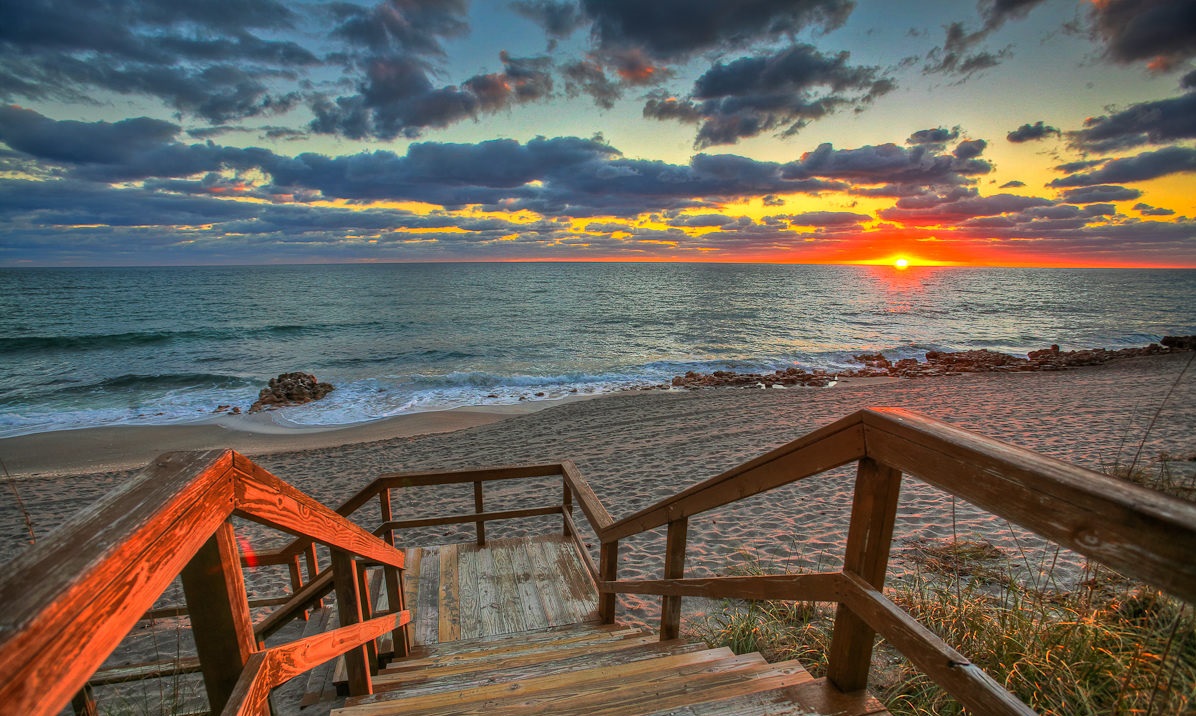
PHOTO CREDIT: KIM SENG VIA FLICKR CC2.0
The last stretch of coastline, which abuts Juno Beach, is commonly known as Jupiter Beach. The station markers and street parking make this a hip place to meet for early morning walks to watch the sunrise or afternoon socials to observe turtle hatchlings. Portions of Jupiter Beach are dog-friendly, so four-legged babies can enjoy “yappy hour” with their canine friends. The park itself offers plenty of parking, restrooms, picnic areas, and outdoor showers. Jupiter Beach Park is a popular place for locals because of its wide shoreline, easy access, and 900-foot fishing pier. Recently, the Jupiter Inlet District, the Florida Inland Navigation District, and the Florida Department of Environmental Protection dredged sand from the inlet and placed 210,000 cubic yards of it along the beach. This restoration project gives Jupiter Beach a wider and flatter coastline. On windy afternoons, the skyline above Jupiter Beach is dotted with colorful kites as kitesurfers put on a spectacular show of jumps, flips, and twists. The turquoise blue water is refreshing for swimmers, and the shoreline fishing appeases anglers. Jupiter Beach is also a perfect shoreline to find shark teeth, collect seashells, or simply bask in the sun while listening to summertime tunes.
When visiting Jupiter, Florida, be sure to spend a day at one of these notable Jupiter beach parks. And after a day at the beach, stop by one of the local pubs for a fresh fish dinner and tasty rum runner. For more information about Jupiter, Jupiter beaches, or Jupiter homes for sale, contact a real estate professional at NV Realty Group.